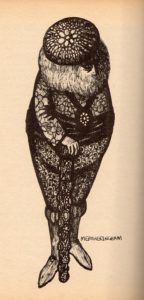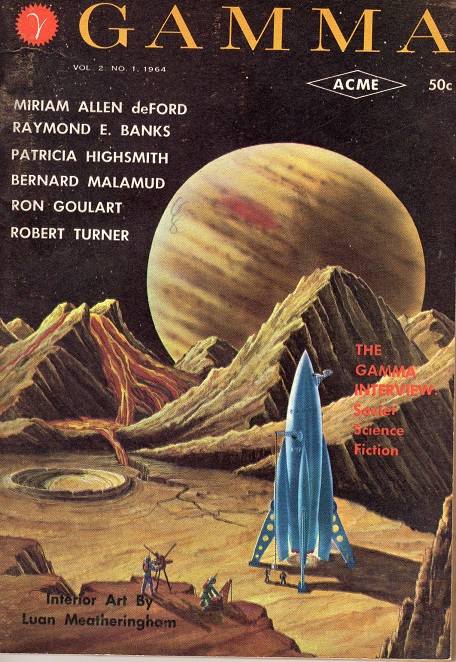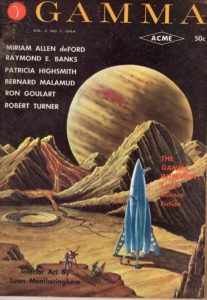Magazine Review: Gamma 3 edited by Charles E. Fritch
Gamma was a short-lived science fiction magazine (five issues in 1963-64), known for high-quality cover art and snagging stories from authors connected with the film industry. (Indeed, I picked up this issue because of the sweet Morris Scott Dollens art.) It was digest-sized and relatively thin. Let’s look at the contents!
“The Girl of Paradise Planet” by Robert Turner concerns retired millionaire George Prentiss. He and his third wife Evvie have come to the title planet on a long vacation (her idea.) Bored, Robert has taken up underwater swimming with future SCUBA gear. This world is not supposed to have any native intelligent life, but then where did that water-breathing naked girl come from? Is George having hallucinations from the water pressure, or is he just going insane?
Over the course of the story, we learn that George is a self-made man who spent his youth starting a business, growing that business and getting rich, so he didn’t look for romance until middle age, and three times went for trophy wives, none of whom have worked out. Which is okay…except that the possibly imaginary Irlana comes across as a Manic Pixie Dream Girl whose function is to rekindle his love of life (and is younger and prettier than Evvie.)
Mr. Turner was an experienced author, but this was his first time writing science fiction, and I can tell. He’s certainly no climatologist, and the ending twist relies on most of the characters forgetting a perfectly logical explanation for events that would be common knowledge to them, even if the reader wouldn’t know it.
“The Feather Bed” by Shelley Lowenkopf presents a bizarre future in which the economy runs on make-work. For example, three years after a building is built, all the piping is torn out and replaced just to give the plumbing crews something to do. This extends to writing as well. Every 37 years, all extant editions of Shakespeare are destroyed, and replaced with “newly written” versions by living authors. Except that it’s just retyping the whole thing verbatim. And the same goes for all other works of fiction by dead writers.
Lew has had it with the system–he doesn’t want to “rewrite” King Lear again, and on the union points system, it will be years before he’s allowed to write more of the original fiction that made him a successful author in the first place. Unfortunately, he’s just one man against the system, and winds up causing even the FBI to intervene. If Lew sticks to his principles, he could lose everything, including the writing he really wants to do.
“Angel Levine” by Bernard Malamud stars Jewish tailor Manischevitz, who is going through hard times. His shop burned down, and the insurance money was eaten by customer lawsuits. His son died in the war, and his daughter ran off with a man and never communicates. He’s got chronic pain, and his wife Rosie is dying. Manischevitz asks God for assistance, but when an “angel” named Levine shows up, there are reasons the tailor is unconvinced. It’s ultimately a story about belief in the face of your assumptions about people. There is racism and anti-Semitism in the story. (This one was reprinted from one of the author’s collections.)
“The (In)visible Man” by Edward W. Ludwig is a fantasy about James Smith, who has become socially invisible. He’s finally decided to exploit that fact, but one person has finally become able to see him, and that is both Mr. Smith’s weakness and best hope. It’s a fairly sweet story, helped along by James Smith, even when he turns criminal, sticking to a “least harm” principle. There is an attempted suicide in the story.
“Inside Story” by Miriam Allen deFord takes place in a far future when the Galactic Federation sends scouts to find new worlds that one of their myriad species can live on and isn’t already inhabited by intelligent life. These planets are exceedingly rare. It looks, however, like this one might be ideal. Presuming the scout party doesn’t find any surprises like rapid inexplicable temperature variations….
In this future, scout ships have mixed-sex crews, but this is because every member of that crew is a different non-compatible species. The twist ending is suitably bizarre.
“The Birth” by George Clayton Johnson is a retelling of a classic story from a different perspective. See how long it takes you to figure out which one!
“Buttons” by Raymond E. Banks concerns John Burke, a starship officer who is forced by disaster to upload his mind to a computer memory storage system. Supposedly, he will have his mind reinserted into his human body once that’s fixed. But that procedure has a high failure rate, and Burke is rapidly discovering the advantages of being a disembodied intelligence. There’s some relatively early thought about the benefits versus possible hazards of transhumanism.
“Society for the Prevention” by Ron Goulart is a humorous piece about the travails of a interplanetary surplus store manager. He’s just gotten a large shipment of extremely ugly wicker urns, the natives of the planet have organized a violent “Shop Local” campaign, and the newly arrived Young Girls Space Police and Welfare Committee officer suspects him of being in cahoots with the inventor of a death ray. Everything more or less works out in the end, but now the store manager has to try to explain to his boss why the urns didn’t get sold. The female Space Police officer is treated as a joke–admittedly so is everyone else, but it may not sit well with some readers, as part of the joke is that women are completely unsuited for the work.
The final story is “The Snail Watcher” by Patricia Highsmith. This creepy tale is about a man who gets a little too fascinated with the reproductive habits of snails, not noticing that these particular snails are reproducing much more rapidly than is anywhere near normal.

Interior art is by Luan Metheringham, who sadly seems to have completely dropped out of sight with only her Gamma appearances known.
There is also an interview with “Ivan Kirov” about the state of Soviet science fiction in the early 1960s. He declined to have his real name published for security reasons. Per the interview, SF in the USSR was beginning to blossom after being suppressed during the Stalinist years. Noted was a tendency for “nuts and bolts” stories of adventure, with little of the social or psychological exploration that had become common in Western nations’ science fiction. (At the time, the government censors were big on Soviet Communism going worldwide being the only possible future, and writers were expected to get on board with that.)
The Banks story is the one that I liked best, though the Highsmith story was also effective. Worth seeking out if you’re a fan of either author or the cover artist.



Sounds like a fun collection of tales, and what a sweet treasure to have snagged! There’s something about vintage science-fiction illustrations that fascinate me. Wouldn’t it be a delight if Luan Metheringham suddenly turned up and we got a peek into a very full portfolio of fabulous pieces?!
It would be nice, yes. Apparently she did freelance storyboarding for television shows, but it doesn’t say which ones.